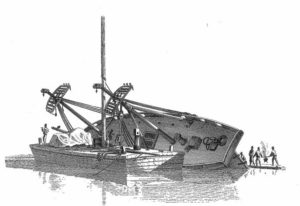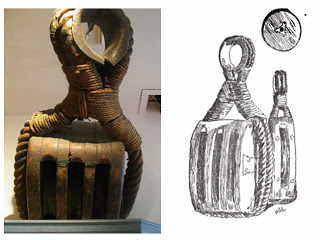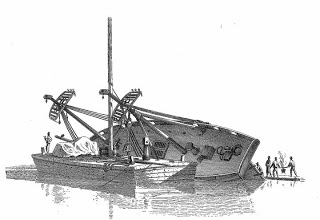High in the museum’s main gallery, looming over visitors’ heads, hangs a massive treble block. Landlubbers might call it a big pulley, but sailors know that a block increases “the mechanical power of the ropes employed in contracting, dilating, or traversing the sails.” This one is a “treble” block because it has three sheaves, or wheels. Blockmakers called this a “made” block, because the shell was composed of several pieces of wood firmly joined with iron bolts.1 Something so massive (it stands 61 inches high-including the hemp strap- and 18 broad) had no use on board ship, but rather served to careen or heave-down a vessel. A common operation in harbors without drydocks, careening a ship allowed shipyard workers to get at her bottom for maintenance or repair. It was a dreadfully dangerous operation, however. After removing all the gear from a vessel and caulking up the gunports, workers connected a series of purchases (consisting of several heaving down blocks and tackle) to the ship’s main and fore masts. By hauling on the tackles using a shore side capstan, the ship slowly heeled over on one side until the keel was nearly free of the water. Careening put a terrible strain on a vessel, and more than once led to disaster.

This brings us back to the giant block in our gallery. It has been on loan to the museum from the Bostonian Society since 1976. The story associated with the piece suggests it was used during Constitution’s launch in 1797, or more likely, to heave her down shortly after to complete the copper sheathing and remove the launching cradle. Supposedly a Boston blockmaker named Daniel Adams made the shell, and Paul Revere cast the brass sheaves and dovetail reinforcing the sheave pins.2

This story provides some wonderful detail, but new information has come to light that casts doubt on the artifact’s date. To begin, Daniel Adams did not set up his Hall’s Wharf shop until June 1803.3 This was six years after Constitution’s launch. Nevertheless, this date corresponds with the ship’s refit in the summer of 1803.
In May, Commodore Edward Preble wrote to the Secretary of the Navy to explain the work:
Tomorrow I shall remove her [Constitution] from her present moorings to a wharf, where I intend to heave her down, and shall have her in readiness for that Operation by the time Mr. Brown can learn from you, what copper he is to supply me with: that made by Mr. Revere, is good, and of proper thickness – if it was not necessary to heave down and copper I could have her ready for Sea in three weeks, but as she is situated at present (no preparation having been made for heaving down except the making of careening blocks) it will be an expensive business, and will detain her some time longer in port.4
This was less than a month before Adams advertised his new shop, and it seems plausible that he could have made the careening blocks needed for the project. Sailing Master Nathaniel Haraden described the newly acquired hardware in his logbook: “The Purchase blocks were three fold [i.e. “treble blocks”], 3 feet 6 Inches each, brass shieves; The Pin was 2 1/2 Inches diameter. Our purchase falls were 10 Inch White 4 strand rope, 140 Fath[oms] each. The lower blocks were secured in Pitts made in the Wharf.”5
The scale of the blocks mentioned by Haraden is close to the actual size of our artifact. The block’s career, post-Constitution, is equally intriguing. Purchased at a sale of surplus goods by Francis Low, owner of F. Low & Co., Riggers, the blocks continued to move heavy loads well into the 19th century. On November 18, 1867, Low used them to lower a siphon into Bass River, completing a new water system for the city of Salem, Massachusetts. The block also helped shift an 84-ton cannon at Castle Island.6 Daniel Adams would be proud.
1 William Burney, A New Universal Dictionary of the Marine (London: T. Cadell and W. Davies, 1815), 41.
2 Elbridge Henry Goss, The Life of Colonel Paul Revere, vol. II (Boston: Joseph George Cupples, 1891), 545-546.
3 Independent Chronicle (Boston), 16 June 1803.
4 Edward Preble to SecNav, 22 May 1803, in Naval Documents Related to the United States Wars with the Barbary Powers, vol. II (Washington, D.C.: Government Printing Office, 1940), 414.
5 “Extract from log book of Sailing Master Nathaniel Haraden, U. S. Navy, of U. S. Frigate Constitution, Captain Edward Preble, U. S. Navy, commanding, Saturday, 26 June 1803,” in Naval Documents Related to the United States Wars with the Barbary Powers, vol. II (Washington, D.C.: Government Printing Office, 1940), 462.
6 Goss, Paul Revere, 546.
The Author(s)
Matthew Brenckle
Research Historian, USS Constitution Museum
Matthew Brenckle was the Research Historian at the USS Constitution Museum from 2006 to 2016.

